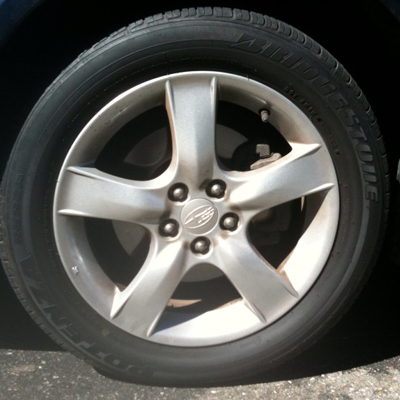 The state Air Resources Board passed a new regulation this week designed to increase fuel efficiency and reduce the state’s greenhouse gas emissions. It requires auto shops to check the tires on their customers’ vehicles and to inflate them to proper levels whenever they are doing an oil change or providing any other service.
The state Air Resources Board passed a new regulation this week designed to increase fuel efficiency and reduce the state’s greenhouse gas emissions. It requires auto shops to check the tires on their customers’ vehicles and to inflate them to proper levels whenever they are doing an oil change or providing any other service.
CARB estimates that if every car in California had properly inflated tires, the state could save 75 million gallons of fuel and reduce emissions by 900 metric tons.
But despite those lofty numbers, the regulation likely won’t affect the lives of consumers very much at all.
“Essentially, the only difference they’ll see if that the technician is going to ask if they want their tires inflated,” said Dmitri Stanich, a CARB spokesman.
Service providers can charge for the service, and it’s likely that many will, said David McClune, executive director of the California Autobody Association. (Auto body shops are exempt from the rule, unless they also offer mechanical services.)
“It could be very minimal,” said McClune. “Some guys might just want to tack on a dollar, or three or four. For others it’s just part of their normal procedure, but I wouldn’t think it would be that costly.”
Customers who don’t want to pay the extra dollars, however, have the right to decline the service. But according to the new rule, they must “affirm” that they have either had their tires checked in the last 30 days or will do so in the next seven.
But what if a customer declines the service, and then, say, forgets to check her tires in the coming days? Will she get busted by the tire police?
Not likely, said Stanich.
“There will be no enforcement officers pulling people over and checking their tire pressure,” he said.
But according to Roland Hwang, the transportation program manager for the Natural Resources Defense Council, maintaining the proper tire pressure is the right thing to do, regardless of the regulation.
“There’s a surprising number of people with under inflated tires,” said Hwang. “And what does that mean? That means you are consuming more fuel and paying more money at the pump. It also means there’s more air pollution being put in the air, and finally, it also means that you are risking your safety.”
But McClune said the new regulation creates more a paperwork, which isn’t sitting well with everyone.
“The additional administrative and compliance stuff is not real positive for some people,” he said.
And even though the rule went into effect on September 1st, McClune said many businesses still aren’t quite sure how to comply.
“At this point, there’s a lot of questions,” he said.
Stanich said there will be a 6-month grace period while CARB works to answer those questions. After that, the rule will be enforced as part of the agency’s existing auditing process.
As for what will happen to the new rule if Propostion 23 passes this November and AB32 is suspended? Stanich said that at this point, the agency’s legal team doesn’t know. If Prop. 23 passes, the regulation may be suspended along with the rest of the law, he said, or it’s possible that the agency would seek reinstate the rule on the grounds of air pollution prevention rather than greenhouse gas reductions.
2 thoughts on “Reducing Emissions with Inflated Tires”
Comments are closed.

Mr. Governor, please return AB2289Eng for an amendment, VETO SB435Pavley, place CARB tire rule, truck and bus rules on hold for review & cancel remote sensing of cars, to improve the air and the State financial condition and it will be fun.
Arnold, BAR & CARB using AB 2289 Eng to cut green collar jobs?
http://www.indybay.org/newsitems/2010/04/18/18645036.php
If an elected official would request a copy of the Sierra Research SR 2007-04-01 report and all communication about the report from CCEEB, CED, CARB, DCA/BAR, IMRC, Parsons, SGS Testcom & Sierra Research it might help improve performance of Smog Check…. “Sherry Mehl. The report has been modified since 2001. Continually”
http://www.youtube.com/watch?v=TvB3em82Lkw